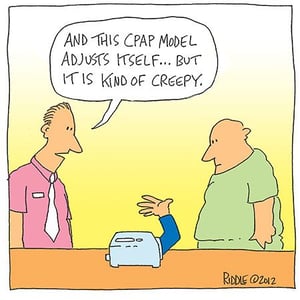I have obstructive sleep apnea and my doctor informed me I need a PAP machine. What's that?
Before we begin, PAP stands for “Positive Airway Pressure.” Since obstructive sleep apnea is caused by a blockage in your airway, the PAP machine will release positive airway pressure into your airway through a mask to clear the airway to prevent the snoring and pauses in breathing. That’s it. If you want to read more about what a PAP machine and the process of receiving one, please continue to read below!
What’s the difference between APAP and CPAP machines?
When speaking about PAP therapy, the doctor will prescribe an APAP machine or a CPAP machine.
 APAP stands for “Automatic Positive Airway Pressure.” The APAP machine will automatically adjust the pressure during your sleep on a breath-by-breath basis to prevent apnea events. APAP therapy has two pressure settings: a low range setting and a high range setting. Therefore, if you have more apnea events when lying on your back, your pressure setting will increase. If you have fewer apnea events when you switch to a different sleeping position throughout the night, the pressure setting will decrease. For this type of machine, you are not required to go to an in-lab sleep facility because you do not require one single pressure setting because the APAP machine can adjust pressure settings depending on your stages of sleep.
APAP stands for “Automatic Positive Airway Pressure.” The APAP machine will automatically adjust the pressure during your sleep on a breath-by-breath basis to prevent apnea events. APAP therapy has two pressure settings: a low range setting and a high range setting. Therefore, if you have more apnea events when lying on your back, your pressure setting will increase. If you have fewer apnea events when you switch to a different sleeping position throughout the night, the pressure setting will decrease. For this type of machine, you are not required to go to an in-lab sleep facility because you do not require one single pressure setting because the APAP machine can adjust pressure settings depending on your stages of sleep.
CPAP stands for “Continuous Positive Airway Pressure” which is a constant and continuous flow of air you must inhale and exhale over. In order to get a CPAP machine, you must go to an in-lab sleep facility to be supervised by a sleep technician so they can decide what pressure is best for you once your titration study is completed. With a CPAP, the settings do not adjust. There is one setting prescribed, and it stays at that particular pressure throughout the night. Some people are unable to tolerate one particular setting because they feel “suffocated” or a “choking sensation” based on the pressure. Depending on the manufacturer of the machine, there is a feature that allows the ability to reduce the pressure upon exhalation.
There are some instances in which CPAP will be more effective for certain patients compared to an APAP machine, while others do well on the APAP machine compared to a CPAP machine. Overall, regardless of what machine type you are prescribed, the important thing is that you are you remain compliant with your treatment option. Treatment options are to be discussed with your doctor to determine what is best for your health.
What’s the process on receiving a PAP machine?

Your doctor will send the order to a Durable Medical Equipment (DME) company. The company will verify your medical coverage. Once your benefits have been verified, you are provided with the explanation of coverage prior to receiving the machine. If you do not have medical insurance, self-pay options are available. You will then be scheduled to receive your machine from a Respiratory Therapist. Usually, the Respiratory Therapist will meet you at their office to review instructions on how to use the machine as well as fit you for a mask that is comfortable. The settings for the machine will be inputted by the Respiratory Therapist. Any additional details in regards to the machine, supplies, or insurance coverage will be explained to you by the Respiratory Therapist or the DME company that provided the machine.
The Takeaway:
Obstructive sleep apnea is treatable, and effective treatment of OSA improves quality of life, improves physical and psychological health, and reduces costs and dangers to society. The most important part of treatment with people with OSA is using the PAP machine whenever they sleep. It will treat and resolve your sleep apnea tremendously, but only if the machine is being used properly. If you are having issues with your PAP machine or still experiencing side effects after treatment, talk to your doctor who prescribed it and ask for help. Successful treatment of OSA can improve all aspects of life.








